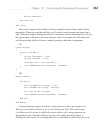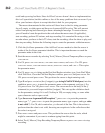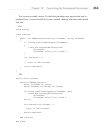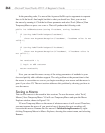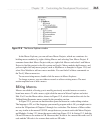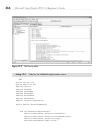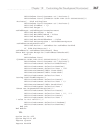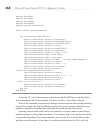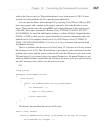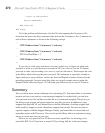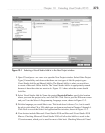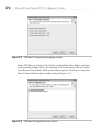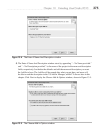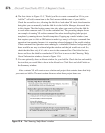
Chapter 12: Customizing the Development Environment 369
work on the file you ran it in. This problem doesn’t occur in the macro for VB. I’ll show
you how to fix this problem, but let’s open the macro editor first.
You can open the Macro editor through VS by selecting Tools | Macros | Macros IDE,
start a new project, add a module to the project, and add a Sub to the Module as a new
macro. Then code the macro by typing DTE. and using Intellisense to find various parts
of the IDE. The cryptic parameter to Windows.Item, {CF2DDC32-8CAD-11D2-9302-
005345000000}, for the Find And Replace window is called a Globally Unique Identifier
(GUID). A GUID is often used as a special identifier for software components and is the
method used in VS to uniquely identify tools. So, DTE.Windows.Item("{CF2DDC32-
8CAD-11D2-9302-005345000000}").Activate() is a way to reference and open the Find
And Replace window.
There is a problem with the macro for C# in Listing 12-3, because it will only work in
the Customer.cs file in VS. The VB code below is provided for your convenience, but this
problem only occurs with the macro written for C# code; the VB macro works fine on the
VB code below. If you created a new class named Product in a file named Product.cs and
added an AddNewProduct method like the following, the macro will try to open and write
into the Customer.cs file, which is not the result you want:
C#:
using System;
namespace ConsoleApplication1
{
class Product
{
public int AddNewProduct(string productName)
{
int newProdID = 0;
// Logic to add product
return newProdID;
}
}
}
VB (doesn’t have problem that occurs in C# code):
Public Class Product
Function AddNewProduct(ByVal productName As String) As Integer
Dim newProdID As Integer = 0



